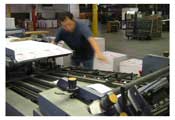 Most of us who work on bindery equipment get pretty good training on how to use the equipment itself, typically through a mix of on-the-job training and instruction by manufacturer’s reps. I suspect that most get very little, if any, training on how to troubleshoot and repair that same equipment. This sort of knowledge is typically a result of experience.
Most of us who work on bindery equipment get pretty good training on how to use the equipment itself, typically through a mix of on-the-job training and instruction by manufacturer’s reps. I suspect that most get very little, if any, training on how to troubleshoot and repair that same equipment. This sort of knowledge is typically a result of experience.
According to Steve Litt of troubleshooters.com and an expert on the troubleshooting process, “…effective troubleshooting requires two assets: 1) knowledge of the system under repair, and 2) knowledge of the repair process. If either is lacking, troubleshooting effectiveness plummets.”
In the printing trade, we get to a certain level of proficiency with time and varied experience. We are forced to troubleshoot in order to keep our equipment running. Litt claims that despite such experience, we will never be as fast and effective as we should be unless we gain an understanding of the troubleshooting process itself.
My own experience bears that out. My first breakthrough with troubleshooting on bindery equipment happened when I looked at a concept that had nothing to do with equipment. This concept was the 80-20 rule (also called the Pareto Principle.)
I realized the 80-20 rule always helped me to quickly root out the cause of the problem. In short, 80% of all problems come from 20% of the possible causes. Those 20% items were almost always of a very basic nature.
For example, in running 16-page right angle signature work with numerous operators, I found that nearly all the problems were the result of just a few machine setup issues in the main parallel section. The perf at the head might be inconsistent, or the first fold varied, resulting in what appeared to be incorrect folding in subsequent sections. Fix the basic item and the problem goes away. I was amazed how often the root cause originated in a basic task gone wrong. (Our related ebook, How to Get the Most from Your Folding Machine Operators, gives more detail on this.)
The 80-20 Rule also works well with what might seem to be too obvious for troubleshooting—consumable items. If an operator is working with a tool that has a consumable component, one of the first questions to ask is “Does the consumable need to be replaced?”
For example a folding machine operator with our Micro Perforator may run without any problems for months, or even years. Then we get a call saying the perf isn’t working any more. That’s when we start the dialog by asking “Does the nylon anvil need replacing?” or “When was the last time you replaced the nylon anvil?” 80% of the time, the problem is fixed with a simple replacement.
As part of your own troubleshooting process you can ask the ‘consumable item’ question about many, many things on bindery equipment. Some typical items that need regular replacement:
- Perf blades
- Cutting knives, both rotary and guillotine. Changing the knife more frequently on the guillotine solves a host of problems. (Here’s a related guillotine cutter article with more detail.)
- Counter knives for both cutting and perfing. These are routinely used well beyond their intended life expectancy. Just because they are hefty, solid pieces of steel doesn’t mean that they don’t need proper care and sharpening or replacement.
- Nylon anvils for our perf tools
- Rubber creasing ribs in our Tri-Creaser®
These obvious items are not always so obvious for good reasons.
1) There isn’t a counter or time-clock telling us when a certain component has reached the end of its useful life. Unless we meticulously keep logs of jobs run with certain tools, we’ll never know exactly when we should be on the lookout. Instead we have to pay ongoing attention to quality as the job is running. Of course we should be doing that anyway. The trick is not to forget to look at the obvious when a problem arises.
2) We often underestimate how much work we really do, kind of like how we easily underestimate how much food we eat. Yes you may have just installed that new cutting knife on your folding machine yesterday. But if you’ve been trimming cover stock all night long, it’s probably time for a knife change.
When troubleshooting a bindery equipment problem, always look to the simplest first. Keep the 80-20 rule in mind with regard to basic tasks and consumable items. This will minimize your troubleshooting time and effort. It also pays to keep at least one spare of any regularly used consumable item on hand. That way you can quickly diagnose whether the consumable is the issue.
Although the 80-20 rule is a fantastic tool, it is just that; a tool in the troubleshooting process. We’ll be looking at the process itself in some upcoming articles.
In the meantime, you may want to check out Litt’s Universal Troubleshooting Process. Warning—the site has a huge amount of information so be prepared to read and work. All you techie-types will enjoy. (I include myself in that group.)
Have a troubleshooting story or resource you want to share? Please share below!

